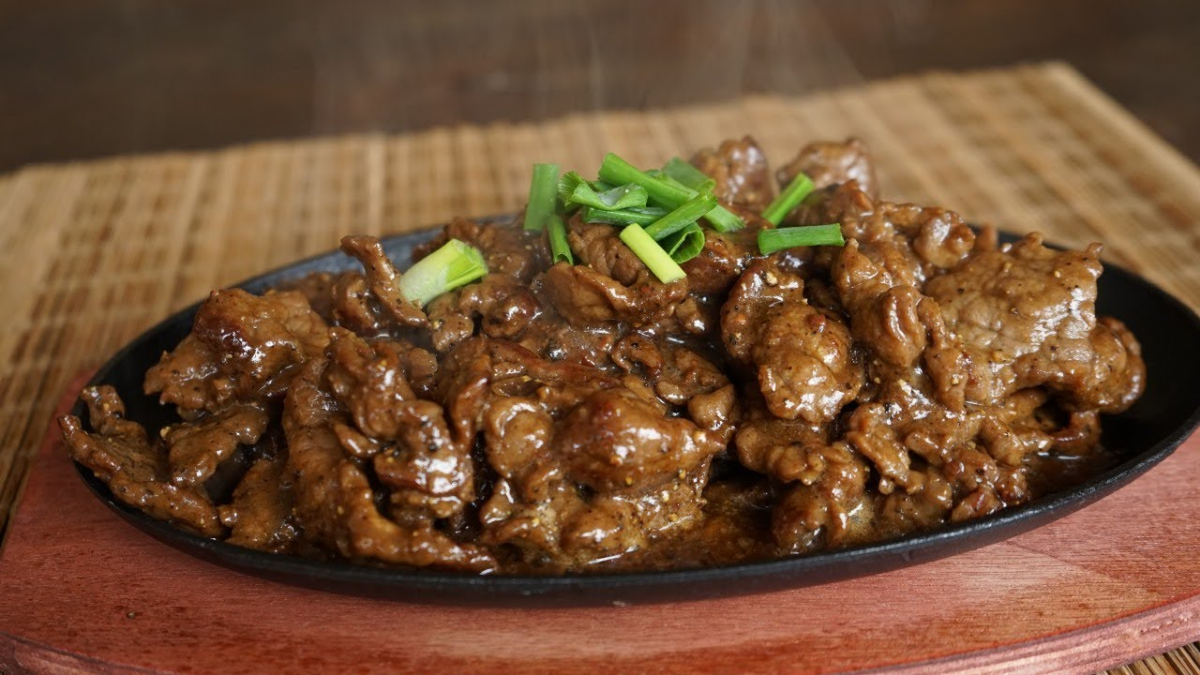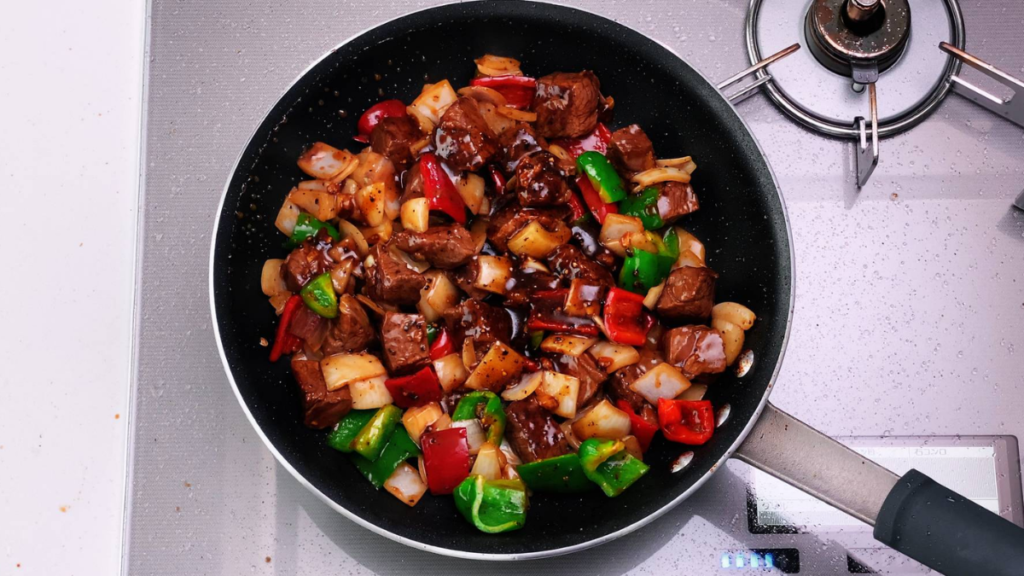Black Pepper Beef is a quick and easy stir-fry made with beef, onions, and peppers that have been seasoned with oyster sauce and black pepper. Big juicy chunks of steak are used in my version of this Chinese classic, giving the meal greater substance and a robust, meaty flavor. Big Bird and Mr. Snuffleupagus, peanut butter and jelly, and the color red on a Ferrari are just a few examples of items meant to be together. Whether you’re from Boston, Bordeaux, or Beijing, you’ve certainly put pepper on your steak at some point, and it’s a classic combination.
This Chinese version of peppered steak is one of my favorites because it puts the powerful flavor of black pepper front and center. Black Pepper Beef offers a delightful blend of tastes, textures, and colors that are sharply highlighted by the smoldering fire of the crushed peppercorns. It has huge savory chunks of beef, sweet onions, and crisp green peppers coated in an oyster sauce glaze.
How to Make Black Pepper Beef?
The first step is to crush the black peppercorns. You can use a mortar and pestle to achieve this, or you can put them in a heavy-duty bag and pound them with a heavy object like a rolling pin or a saucepan.
To make the black pepper sauce, combine the crushed black pepper (reserve a little for garnish), oyster sauce, Shaoxing wine, soy sauce, and sesame oil in a mixing bowl. You can stop here and bottle the sauce if you create a large batch and store it.
If you want to keep the stir-fry going, whisk in the potato starch until there are no lumps. Combine the cubed beef and the marinade in a mixing bowl, and allow it cool while preparing the garlic, onions, and peppers. Heat a frying pan over medium-high heat until it’s heated once you’ve gathered all of the ingredients. Stir in the oil and garlic for a few minutes before adding the steak in a single layer with tongs or chopsticks.
Don’t just dump everything into the pan; you want to leave as much of the marinade in the bowl as possible. Flip the cubes over and brown the opposite side when the first side has browned. This combination of a Western steak with a Chinese stir-fry reduces the quantity of meat used. The steak bites are caramelized and delicious on the surface and soft and juicy on the inside. It’s exactly the kind of steak dish I crave when I get a craving for it. Best of all, there’s no need to stress over perfectly cooking a thick slab of meat. Because the vegetables are included, they’re flavorful, and there’s only one skillet to clean at the end.
After the beef has browned on all sides, add the onions and bell peppers and stir-fry until the onions have turned translucent. Toss everything with the remaining black pepper sauce until the sauce thickens around the beef and vegetables. Serve the black pepper beef on a plate with a sprinkle of crushed black pepper on top.
Even though the two peppers are unrelated, they share a history. Black pepper arrived in Europe via the spice trade and quickly gained popularity as a flavoring for its ability to bring foods to life with its subtle burn.
Black pepper became such a valuable commodity due to its scarcity that some say it was worth more than gold. It wasn’t long after explorers began bringing chili peppers back from the Americas for their decorative characteristics that people realized the colorful fruits could also be used to spice up food. What began as a gastronomic rip-off of black pepper has taken on a life of its own in kitchens.
Ingredients
- 6 g black peppercorns, whole
- (2 teaspoons) 350 g tenderloin de boeuf (or another steak cut, cut into
- 3/4-inch cubes)
- Two tbsp. sauce oyster
- 1 tbsp. wine (Shaoxing)
- One tbsp. sriracha
- One teaspoon of sesame oil, roasted
- 1 tsp. starch (potato)
- One tbsp. oil (vegetable)
- One small onion, sliced into
- 1/2-inch squares
- (140 grams)
- 100 g bell peppers
- (half red, half green)
- 12 g garlic (2 large chopped cloves)
Instructions
- Put the black peppercorns in a mortar and coarsely crack them with a pestle. If you don’t have a mortar and pestle, crush the peppercorns with a rolling pin in a freezer bag.
- Use a mortar and pestle to crack black peppercorns.
- Whisk together the oyster sauce, Shaoxing, soy sauce, sesame oil, and most of the black pepper in a mixing dish (saving a little to garnish). Mix in the potato starch until no lumps are remaining. Stir in the steak to evenly coat it, then set it aside to marinate while preparing the vegetables.
- Beef tenderloin marinated in Chinese black pepper sauce.
- Once you’ve completed all of the prep work, heat a frying pan over medium-high heat until it’s hot. Toss in the vegetable oil, then add the beef in a single layer with tongs. As much of the marinade as possible should be left in the bowl.
- In a frying pan, brown beef that has been marinated in black pepper sauce.
- Fry the meat on one side until golden brown, then flip and cook the other side until golden brown.
- Turn the heat to high and add the onions, bell pepper, and garlic to the pan. Stir-fry, tossing the contents of the pan from time to time to ensure equal cooking.
- Onions and peppers are stir-fried with seasoned meat.
- Add the remaining marinade and toss everything together until the black pepper beef is glossy and uniformly coated with sauce.
- Use Chinese black pepper sauce to glaze the steak.
- Serve with rice and a pinch of black pepper on top (to taste).
What is the Best Way to Prepare Black Pepper Meat?
Toss the steak slices with 1 tsp black pepper and 14 tsp salt in a mixing bowl. In a wok (or big frying pan), heat three tablespoons of sunflower oil and one tablespoon of sesame oil until hot, then add the steak. Fry the steak for 2-3 minutes, turning it around in the wok to avoid sticking together until browned. Cutting the steak against the grain also helps to keep it tender. When sliced against the grain, even the toughest cuts of beef become much softer. Cutting a steak against the grain shortens the long muscle fibers, making it easier to chew.
Black pepper and its major ingredient, piperine, may have anti-inflammatory and antioxidant benefits. Black pepper has improved cholesterol levels, blood sugar control, and brain and intestinal health. Add black pepper to meats, seafood, vegetables, salad dressings, soups, stir-fries, pasta, and other dishes to add flavor and spice. Add a little black pepper to scrambled eggs, avocado toast, fruit, and dipping sauces for a spicy kick.
What is the Best Way to Prepare Chinese Salt and Pepper Beef?
Drizzle a tablespoon of oil into the pan, add the garlic slices and swirl for 5 seconds before adding the onion and pepper pieces. Toss for 1 minute, then return all meat strips to the pan. To combine all ingredients, sprinkle the seasoning spices on top and toss thoroughly for 1 minute. Place on a serving platter and serve right away! Place the seasoned meat in the cooker and simmer on low heat until all of the liquid has been absorbed. Allow the vegetable oil to heat up in an empty dry saucepan, then add the prepared meat and fry for 7 to 10 minutes without drying up.
These beef strips are ideal for stir-frying in a wok or a large frying pan, as the name implies. They will take 2-4 minutes to cook in a heated pan. Season both sides of the beef slices and lay them flat. Single stack the beef slices in the air frying tray (each slice must be single stacked or they will not get crispy) and air fried for 45-60 minutes at 200F. Allow beef slices to cool for 5 minutes before serving.
Is it Possible to Cover the Beef in Maize Flour?
Corn flour should be used to coat the beef strips. Ensure that all of the beef strips have been separated. Before cooking, toss aside any extra flour. Heat the oil to 350 degrees Fahrenheit. Coating small pieces of chopped meat, fish, shrimp, or even cauliflower in cornstarch before sautéing or stir-frying results in a crispy coating after only a few seconds in the hot oil. Putting flour on meat before browning it on a hot skillet is straightforward: Flour has a lot of starch, which caramelizes quickly and gives the food a richer color and flavor.
This method is most commonly employed in stews when flour thickens the cooking liquid. You can do either, according to the response. However, traditionally, flour is used to coat the meat, and there are various reasons for this: Flour aids in the browning of the meat, enhances the flavor of the sauce, and improves the surface texture of the meat. Cornstarch: When added to marinades, cornstarch coats the meat in a light coating that protects it from the wok’s strong heat. This prevents overcooking and toughening the meat’s outer layers.
What’s the Best Way to Create Crispy Beef Chips?
Drain and wipe dry the beef slices before placing them flat in the dehydrator baskets. Please make sure there are enough spaces between each slice for them to pass through easily. Preheat your Baumann Food Dehydrator to 65 degrees Celsius, then dehydrate for 12 to 15 hours, or until the jerky chips are crunchy. Leave the skins on the potatoes and slice them into half-cm thick chips. Toss the chips with olive oil, salt, and pepper in a mixing bowl. Bake for 30 minutes, or until golden and crisp, on a baking tray.
Place strips on your dehydrator drying racks with plenty of room between them to allow air to circulate freely. Dry for 3 hours at 165°F, until the internal temperature reaches 160°F, and then reduce to 145°F. After 4 hours, check the meat and continue to dry until the jerky bends and splits but does not break in half. The USDA Beef and Chicken Hotline recommends heating meat to 160 degrees Fahrenheit and poultry to 165 degrees Fahrenheit before dehydrating to make jerky properly. The moist heat will kill any germs present in this stage.
Conclusion
I used Malabar Coast black pepper, but all black peppercorns would do. While pre-ground pepper will work in this recipe, I don’t recommend it because many of the complex scents of black pepper begin to dissipate as soon as the peppercorns are crushed. That’s why pre-ground pepper doesn’t have the same aroma as freshly cracked pepper. What is the shelf life of Chinese Black Pepper Sauce? You could make a large quantity of this sauce and keep it in the fridge for months in an airtight container.
I don’t recommend adding the starch if you plan to keep it (you can add it when you use it). This makes the sauce more adaptable, as starch isn’t always required. What am I able to do using Chinese Black Pepper Sauce? The sauce is also a great marinade for grilled chicken and steamed fish, and stir-fries like these. I also like to use it to make stir-fried noodles, but skip the starch if you’re using it for noodles.

